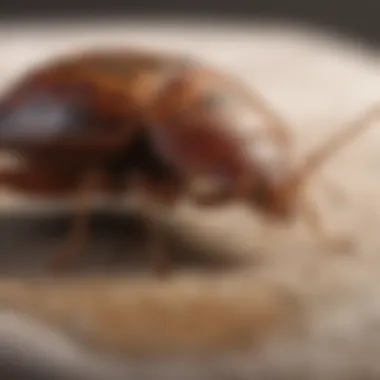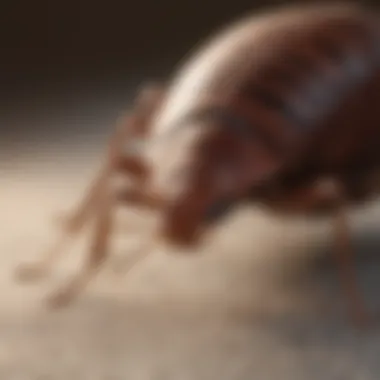Discovering the Ultimate Guide to Milwaukee Bed Bugs: Identification and Eradication Insights


DIY Pest Control Techniques
For those who prefer a hands-on approach to pest control, do-it-yourself (DIY) techniques offer practical and cost-effective solutions. Homemade pest control remedies provide eco-friendly options to protect against pests using simple ingredients and methods. Incorporating essential oils for pest control can help in naturally repelling pests and maintaining a bug-free environment at home.
Setting up effective pest traps and barriers can aid in controlling and preventing pest infestations. By strategically placing traps and barriers, you can minimize pest activity in your living spaces. Choosing reputable pest control brands ensures that you have access to quality products for managing pest issues effectively. Exploring miscellaneous DIY pest control techniques offers unique solutions tailored to different pest problems at home.
Introduction
In Milwaukee, dealing with bed bugs is a significant concern for many homeowners. This comprehensive guide on the identification and eradication of bed bugs aims to offer valuable insights and practical strategies to combat this persistent pest problem effectively. By understanding the nuances of bed bug behavior, signs of infestation, associated health risks, and prevention techniques, readers can equip themselves with the necessary knowledge to tackle this issue head-on. Whether you're encountering these pests for the first time or seeking more effective eradication methods, this guide will walk you through every crucial step.
Understanding Bed Bugs
Physical Characteristics of Bed Bugs
The physical appearance of bed bugs plays a crucial role in their identification. These reddish-brown insects are small and flat, allowing them to hide easily in cracks and crevices. Their distinct oval-shaped bodies lack wings, but they have six legs and are capable of quick movement. Understanding the physical characteristics of bed bugs is essential for accurate identification when implementing eradication measures. Despite their minuscule size, these pests can cause significant disruptions in households, necessitating prompt and effective action.
Behavior and Habitat
Bed bugs are nocturnal creatures that prefer to feed on human blood during the night. Their secretive behavior and tendency to reside close to their hosts make them challenging to detect. These pests commonly inhabit bedding, furniture, and other secluded areas, making eradication efforts intricate. By delving into the behavior and habitat preferences of bed bugs, individuals can develop targeted strategies to disrupt their lifecycle and prevent infestations from escalating. Recognizing the behavior patterns of these insects is paramount for successful eradication and long-term prevention.
Signs of Bed Bug Infestation
Visible Signs


Detecting visible signs of bed bug presence is imperative for early intervention. These signs include dark fecal spots on bedding, shed exoskeletons, and bloodstains on linens. Recognizing the tell-tale indicators of bed bug infestation allows homeowners to take timely measures to address the issue before it exacerbates. The visibility of these signs varies based on the extent of infestation, highlighting the importance of vigilance and thorough inspection in maintaining a pest-free environment.
Common Bite Reactions
Bed bug bites manifest as red welts on the skin, often in a clustered pattern. While the physical discomfort associated with these bites is bothersome, some individuals may experience severe allergic reactions. Understanding the common bite reactions caused by bed bugs aids in differentiating them from other insect bites and seeking appropriate medical attention when necessary. By educating oneself about typical bite responses, individuals can effectively gauge the presence of bed bugs and take decisive action to mitigate their impact.
Health Risks Associated with Bed Bugs
Potential Health Impacts
Beyond physical discomfort, bed bug infestations can have adverse health effects. Prolonged exposure to these pests may lead to skin infections, allergic reactions, and, in rare cases, anemia. Upholding stringent hygiene practices and implementing eradication measures are crucial in mitigating the potential health impacts of bed bug infestations. Heightened awareness of the health risks associated with these pests empowers individuals to prioritize proactive pest management and safeguard their well-being.
Psychological Effects
Apart from the physical ailments they cause, bed bugs can exert a significant toll on mental health. The constant anxiety and stress stemming from sleep disturbances and the fear of infestation recurrence can lead to emotional strain. Understanding the psychological effects of bed bug infestations enables individuals to address not only the physical aspect but also the emotional ramifications. By fostering a holistic approach to combating bed bugs, individuals can better protect their mental and emotional well-being amidst pest-related challenges.
Identification
In this section of the comprehensive guide to Milwaukee bed bugs, the focus is directed towards the critical aspect of identification. Without proper identification, effective eradication and prevention strategies cannot be implemented. Identifying bed bugs promptly is crucial in preventing infestations from spreading and causing further issues. By accurately recognizing the key characteristics and signs of bed bugs, homeowners can take swift action to address the problem before it escalates further.
Visual Identification
Adult Bed Bugs
Adult bed bugs play a vital role in the identification process due to their distinct physical features. Their reddish-brown color, oval-shaped bodies, and small size make them easily identifiable to the trained eye. Adult bed bugs are wingless insects with six legs and antennae, allowing them to navigate through living spaces and feed on hosts discreetly. Understanding the appearance of adult bed bugs assists in differentiating them from other common household pests, enabling homeowners to pinpoint infestation sites efficiently.


Nymphs and Eggs
Nymphs and eggs represent critical stages in the bed bug life cycle, contributing significantly to the overall identification process. Nymphs are miniature versions of adult bed bugs but lack wings and are lighter in color. Their size and translucent bodies make them harder to detect, emphasizing the necessity of thorough inspections. Bed bug eggs, on the other hand, are tiny, white ovals, typically found clustered in secluded areas like mattress seams and crevices. Recognizing the presence of nymphs and eggs aids in confirming infestations and planning appropriate treatment methods.
Using Bed Bug Monitors
Types of Monitors
Different types of bed bug monitors serve as essential tools in detecting and monitoring infestations. Passive monitors, interceptors, and active monitors offer varying capabilities in capturing bed bugs at different stages of development. Passive monitors rely on bed bugs' natural movements, while interceptors trap bugs as they attempt to climb furniture legs. Active monitors use bait to attract bed bugs, providing an active surveillance method for ongoing monitoring. Selecting the appropriate monitor type based on the infestation's severity and location enhances the effectiveness of identification and tracking efforts.
Placement Techniques
Strategic placement of bed bug monitors plays a crucial role in successful detection. Placing monitors near potential harborage sites such as beds, couches, and baseboards increases the likelihood of capturing bed bugs. Monitoring commonly infested areas regularly and relocating monitors based on activity levels optimizes surveillance efficiency. Effective placement techniques not only aid in early detection but also assist in gauging the efficacy of eradication methods through monitoring trends and infestation patterns.
Prevention
In addressing the topic of prevention within the comprehensive guide to Milwaukee bed bugs, it is crucial to emphasize the significance of proactive measures to combat these resilient pests. Prevention serves as the primary line of defense against bed bug infestations, highlighting the importance of early detection and strategic interventions. By focusing on preventative strategies, individuals can mitigate the risk of infestations and safeguard their homes from these unwelcome intruders.
Strategies for Prevention
Regular Cleaning Practices
Diving into the realm of regular cleaning practices in the context of bed bug prevention, the meticulous attention to cleanliness plays a pivotal role in disrupting the potential harborage of bed bugs. Routinely cleaning living spaces, including vacuuming, dusting, and decluttering, not only eliminates existing bed bugs but also eradicates their potential hiding spots. This methodical approach to cleanliness proves to be an effective and popular choice within the realm of bed bug prevention due to its proactive nature and long-lasting impact. Implementing regular cleaning practices reduces the likelihood of bed bug infestations, offering a holistic solution that promotes a healthy living environment.
Bedding and Mattress Care


When delving into the realm of bedding and mattress care as part of bed bug prevention, the meticulous attention to hygiene and maintenance becomes paramount. Proper maintenance of bedding, including regular washing, drying on high heat, and utilizing bed bug-proof encasements, creates an inhospitable environment for these pests. The key characteristic of bedding and mattress care lies in its ability to create a barrier against bed bugs, effectively preventing their entry or escape. This approach stands as a popular and beneficial choice for bed bug prevention, providing a comprehensive shield that enhances the overall protection against infestations. The unique feature of bedding and mattress care lies in its proactive nature, safeguarding against potential infestations without relying solely on reactive measures.
Travel Tips to Avoid Bed Bugs
Inspecting Hotel Rooms
Exploring the nuances of inspecting hotel rooms within the scope of bed bug prevention, the meticulous examination of potential accommodations is instrumental in mitigating the risk of infestations. By scrutinizing hotel rooms for signs of bed bugs, such as dark spots on bedding or furniture, travelers can make informed decisions to avoid potential exposure. The key characteristic of inspecting hotel rooms revolves around proactive vigilance, empowering individuals to safeguard their belongings and well-being while traveling. This practice stands as a beneficial and popular choice for travelers, offering peace of mind and assurance against encountering bed bugs during their stay. The unique feature of inspecting hotel rooms lies in its ability to proactively prevent infestations, ensuring a comfortable and secure travel experience.
Packing and Unpacking Procedures
Turning to the realm of packing and unpacking procedures as a preventive measure against bed bugs, the meticulous approach to handling luggage and belongings is pivotal in avoiding infestations. By sealing clothing and belongings in tightly closed bags or containers during travel, individuals can prevent the inadvertent transport of bed bugs. The key characteristic of packing and unpacking procedures lies in their role in minimizing the risk of introducing bed bugs into living spaces, promoting a proactive approach to preventing infestations. This method emerges as a beneficial and popular choice for individuals seeking to maintain a bed bug-free environment, emphasizing the importance of precautionary measures. The unique feature of packing and unpacking procedures lies in their ability to offer added protection against the inadvertent spread of bed bugs, enhancing travel experiences and minimizing potential risks.
Eradication
Eradication is a crucial aspect in the comprehensive guide to Milwaukee bed bugs. Effectively eliminating bed bugs from your home is paramount in ensuring a pest-free environment and safeguarding the well-being of residents. The eradication process involves thorough measures to eradicate both adult bed bugs and their eggs, disrupting their life cycle and preventing future infestations. By focusing on eradication, individuals can address the root cause of the problem and prevent its recurrence, offering long-term relief and peace of mind.
DIY Treatment Methods
When it comes to handling bed bug infestations, DIY treatment methods are a popular choice for many homeowners. These methods often involve using natural remedies that are eco-friendly and safe for both humans and pets. Natural remedies, such as essential oils and diatomaceous earth, offer a non-toxic approach to eliminating bed bugs, minimizing the risk of chemical exposure in the household. While natural remedies may take longer to show results compared to conventional treatments, their efficacy and sustainability make them a preferred option for those looking for a holistic solution to bed bug problems.
Steam Treatment
In the realm of bed bug eradication, steam treatment stands out as an effective and environmentally friendly solution. Steam treatment works by using high temperatures to kill bed bugs at all stages of their development, from eggs to adults. The key characteristic of steam treatment lies in its ability to penetrate deep into furniture, mattresses, and crevices where bed bugs hide, ensuring comprehensive eradication of the pests. Unlike chemical treatments, steam treatment is non-toxic, making it safe for use around children and pets. While steam treatment may require professional-grade equipment for optimal results, its advantages in terms of efficacy and safety make it a valuable method in the battle against bed bugs.
Professional Extermination Services
For individuals facing severe bed bug infestations or seeking a comprehensive solution, professional extermination services offer expertise and efficiency in eradicating bed bugs. Hiring a pest control company brings specialized knowledge and resources to tackle even the most challenging infestations. The key characteristic of professional extermination services is the personalized approach to bed bug treatment, utilizing tailored strategies based on the extent of the infestation and the property layout. While the cost of professional services may be higher than DIY methods, the thoroughness and effectiveness of treatment procedures often justify the investment, providing long-lasting relief from bed bugs.
Treatment Procedures
When engaging professional extermination services, treatment procedures play a pivotal role in ensuring the success of bed bug eradication efforts. Treatment procedures typically involve a multi-step process, starting with inspection and assessment to identify the extent of the infestation. Subsequent steps may include targeted application of pesticides, heat treatment, or fumigation, depending on the severity of the infestation. The unique feature of treatment procedures lies in their systematic approach to eliminating bed bugs, addressing both visible insects and hidden populations. While treatment procedures may require multiple visits for complete eradication, their thoroughness and attention to detail ensure a high level of success in resolving bed bug infestations.



